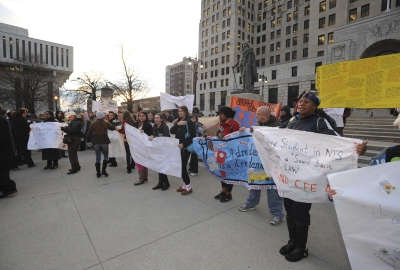
By Norm Fruchter & Christina Mokhtar-Ross
Kudos to the New York State legislature, which ended decades of legal and political struggle by fully funding the Campaign for Fiscal Equity’s court mandate. Starting this July, New York City will receive an initial $1.4 billion down-payment on the accumulated debt the state owes the city’s schools, based on the New York State Court of Appeals 2006 final decision in CFE v State of New York.
The Campaign for Fiscal Equity (CFE) was a coalition of community school board members, education advocates and parent groups, founded in 1993 by Michael Rebell, an education lawyer and scholar and Robert Jackson, a Bronx community school board president. (Full disclosure: my wife, Heather Lewis and I were among the founding members and served for many years on the CFE board.) The CFE lawsuit argued that New York’s governors and legislatures, by consistently and severely underfunding NYC’s schools, failed to provide the “sound basic education” that New York State’s constitution guarantees all the state’s students.
The CFE lawsuit was filed in 1999. In 2001 Judge Leland deGrasse ruled for CFE, finding the state’s school funding system unconstitutional. Governor Pataki appealed Judge deGrasse’s decision and several rounds of court action followed. In 2006, the Court of Appeals, New York State’s highest tribunal, ruled in favor of CFE and directed the state legislature to substantially increase education funding to NYC schools.
In 2007 the legislature complied, but the savage 2008 recession forced severe budget cuts at state and local levels of government across the following decade. Since 2008, New York State has never met its constitutional and legal obligation to fund NYC schools in compliance with the CFE decision. So almost 30 years after the CFE lawsuit was launched, the New York State legislature’s full funding of the CFE mandate heralds a new era of fiscal equity for NYC’s schoolchildren.
NYC’s Fair Student Funding
Mayor de Blasio recently followed the state legislature’s historic action by deciding that the city would use its enriched state and federal education dollars to fully fund the city’s Fair Student Funding (FSF) formula. The FSF, one of the Bloomberg administration’s few unequivocally equitable school reforms, replaced the arbitrary and irrational methods through which previous DOE administrations funded the city’s schools. The FSF was developed in 2006 and implemented in 2007, using the initial round of court-ordered CFE funding. But given the ravages of the 2008 recession on state and the city’s budgets, the state never fully funded the CFE mandates and the city consequently couldn’t fully fund the FSF formula. As a result, since 2008 most of NYC’s schools have received less funding than their FSF allocations called for. In 2018, according to a study by the Independent Budget Office (IBO), the city fell almost $500 million short of full FSF funding, leaving almost 80% of the 1,533 city schools with smaller FSF allocations than they should have received. For many schools, FSF underfunding was severe. More than 900 schools needed $500,000 or less in 2017-2018 to reach their full FSF share, almost 300 schools needed more than $500,000, and some 60 schools were shorted more than $1 million. The mayor’s decision to fully fund all the FSF’s formula allocations ends almost 14 years of systemic school underfunding and finally establishes standardized measures of fiscal equity at the school level.
How does the FSF work?
FSF is based on a series of needs-based weightings. All schools receive a base allocation; added to that allocation is the sum of all the formula’s relevant category weights, multiplied by the number of students in each category. The table below summarizes all the FSF need categories, their weightings, and the resulting per-student dollar amounts allocated. Although many schooling activists disagree with some of the weightings for specific student categories (as do we, see our criticisms below), the FSF’s comprehensive, standardized and equitable funding system for all the city’s schools constitutes a major achievement.
|
Grade and Needs-Based Weights for Fair
Student Funding |
||
| Weight |
$ Per
Student |
|
|
BASE WEIGHT
Grade |
||
| K-5 | 1.0 | $3,788 |
| 6-8 | 1.08 | 4,091 |
| 9-12 | 1.03 | 3,902 |
SPECIAL NEEDS WEIGHTS Academic Intervention |
||
| Entering Before 4th Grade Poverty |
0.24 | 909 |
| Entering 4th to 5th Grade Below Standards Well Below Standards |
0.25 947 |
0.40 1,515 |
| Entering 6th to 8th Grade Below Standards Well Below Standards |
0.35 1,326 |
0.50 1,894 |
| Entering 9th to 12th Grade Below Standards Well Below Standards |
0.25 947 |
0.40 1,515 |
|
English Language Learner | ||
| K-5 | 0.40 | 1,515 |
| 6-12 | 0.50 | 1,894 |
|
No Child Left Behind (NCLB) Transfer |
||
|
NCLB Transfer
Special Education |
0.53 | 2,000 |
| Less than 20 Percent of Day | 0.56 | 2,121 |
| 20 Percent to 60 Percent of Day | 0.68 | 2,576 |
| Over 60 Percent, Self-Contained | ||
| K-8 | 1.23 | 4,659 |
| 9-12 | 0.73 | 2,765 |
| Over 60 Percent, Inclusion | ||
| K-8 | 2.28 | 8,637 |
| 9-12 | 2.52 | 9,546 |
|
PORTFOLIO WEIGHTS |
||
| Specialized Academic | 0.25 | 947 |
| Specialized Audition | 0.35 | 1,326 |
| Career and Technical Education | ||
| Nursing | 0.26 | 967 |
| Health, Trade, Technical | 0.17 | 629 |
| Business | 0.12 | 451 |
| Home Economics, Arts | 0.05 | 193 |
| Transfer | 0.40 | 1,515 |
|
SOURCES: IBO; Department of Education. |
||
As the table above demonstrates, each student receives a base weight reflecting their grade level–students in higher grades receive slightly larger weights. There are also three categories of needs-based weights: academic intervention for low-performing students, as well as weights for English Language Learners and for students receiving special education services. The academic intervention weight is based on standardized testing and is assigned when students enter school. When student entry occurs before third grade (the initial year for standardized testing), poverty becomes a proxy for low academic achievement. Starting with fourth grade, students who are either below standards or well below standards, depending on test results, qualify for academic intervention weights, with a higher weight allocated to students who are well below standards. Given the sharp drop in achievement in middle schools, higher weights are allocated for poorly performing students in grades six to eight than in earlier or later grades.
Students who are English Language Learners receive an additional weight, with slightly higher weightings at the middle and high school levels. Weights for students receiving special education services are based on how much of the school day students spend in special education classes and whether those classes include general education students or only special education students. Finally, four types of what the DOE calls portfolio high schools are allocated additional weights: specialized academic and audition schools, career schools and technical education schools.
Should the FSF weightings be reconsidered?
Since the FSF system was formulated in 2006 and implemented in 2007, it’s time to consider some mid-course corrections. We accept that working with middle school early adolescents who must navigate the switch from full day classes to departmentalized subject area instruction involves complex challenges that deserve extra weightings. But because we’re not convinced that high schools face lesser challenges, we would give equal weights to both middle and high school students.
Another weighting for high schools seems more problematic – the weighting for specialized academic high schools under the Portfolio Schools heading. An examination of this issue in 2017 by Mike Elsen-Rooney for the Hechinger Report identified the specialized academic high schools that receive a 0.25 FSF weighting: the three original exam schools, (Stuyvesant, Bronx Science and Brooklyn Tech), the five additional high schools the Bloomberg administration added to the exam school category (Queens High School for the Sciences at York College, Staten Island Technical High School, Brooklyn Latin School, the High School of American Studies at Lehman College, and the High School for Mathematics, Science and Engineering), as well as the two Bard College High Schools in Manhattan and Queens, Townsend Harris High School in Queens, Millennium High School in Brooklyn and the NYC iSchool. Rooney indicated that the weighting provided “an annual bonus of almost $1,000 per student at 13 of the city’s elite high schools, where students are wealthier than the city average and alumni foundations can raise millions of dollars for extras.”
Because the FSF formula is needs-based, providing a weighting for students from predominantly advantaged families seems both illogical and inequitable. Why reward high schools serving students who have been selected precisely because of their high academic outcomes rather than their academic need, which the FSF was designed to compensate for? How does the DOE identify these schools’ student needs, to make them eligible for additional weighting, compared to the obvious needs the FSF categories fund? If these schools are over-crowded, suffer from high student to teacher ratios or over-burdened teacher course loads, categories reflecting those hardships should be added to the FSF formula, since other high schools undoubtedly share the same burdens. Why reward these thirteen schools with additional funding?
In the same category of Portfolio Schools in the table above is a weighting of .05 for Home Economics and Arts, for schools specializing in those areas. That weighting may be sufficient for schools concentrating on Home Economics, but it seems quite limited for schools providing varieties of intensive involvement in Art, Music, Dance, Film and TV experience. The field-specific materials, studio space, and equipment these schools must provide to offer a comprehensive arts concentration seems to require a weighting significantly higher than 0.05.
Revisions of the FSF should also consider an additional weighting for schools serving concentrations of homeless students. More than 10% of the city school system’s population, or 110,000 students, currently live in shelters, other temporary housing, or are doubled or tripled up with relatives or friends. These homeless students are not spread evenly across the city’s 32 community school districts, but are concentrated in a relatively small number of schools overburdened by the challenges their homeless students face. Those challenges often involve severe health, nutritional, social and emotional needs, transportation obstacles, frequent schooling disruptions, inability to access the Internet, lack of study space, limited school materials–all linked to low attendance rates and limited academic achievement. The pandemic has exacerbated the multiple traumas homeless students face, the learning losses they suffer, and the struggles schools face to reach, engage and support them. Creating an FSF weighting for homeless students would support their schools’ efforts to ease the pandemic’s toll on those students and their families.
The thousands of parents, advocates and partisans of equitable schools who consistently supported the demands of the Campaign for Fiscal Equity and its sister organization, the Alliance for Quality Education, for almost three decades, should be celebrated for their ceaseless advocacy for the funding our students and their students need. The state legislature and the city’s mayor have provided a rare moment of triumph for them and for all of us.
Christina Mokhtar-Ross, Ph.D., Independent Education Research Scholar, formerly at the Annenberg Institute for School Reform and the Department of Social Policy, University of Oxford

